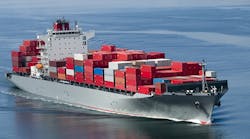In the early days of July, while most Americans slowed down to celebrate their country’s independence, a single ship sped toward China, racing against a series of new tariffs that would go into effect on July 6th.
Many watched as the U.S. cargo ship Peak Pegasus made its way toward the port of Dalian with a load of soybeans. If everything went right, the ship would have arrived with about an hour to spare before the tariffs went into effect. But as is often the case in the world of supply chain, the ship did not come in as planned. And instead of being the last ship to beat the clock, Peak Pegasus was among the first to be hit with China’s new 25% tariff on American agricultural imports.
The Peak Pegasus and its $20 million cargo of soybeans continued to drift off the Chinese coast until mid-August, at a cost of about $12,500 each day it sat idle.
Its story illustrates that most efforts to outpace disruption are ultimately limited by the physical and financial constraints inherent to moving goods around the globe. Whether it is a hurricane or factory fire, new trade regulation or an unexpected supplier bankruptcy, much of how products are made and moved happens outside of our control.
There is no single fix for the many challenges businesses confront each day. But as companies have become more adept at dealing with unexpected changes, several technologies have emerged to help manage risk and minimize losses.
Visibility Is a Foundation
The term visibility has a few different definitions depending on whom you ask. And in many cases, visibility is simply a matter of having regular status updates or reports between a company and an individual supplier, factory, carrier, or bank. Sometimes it is done in a supplier portal or managed by a logistics provider, but rarely is visibility comprehensive.
However, in a world where most of the information about a supply chain exists outside of the enterprise, visibility is a fundamental part of managing risk. Businesses that have end-to-end visibility of their supply chain are able to react to change more quickly and reduce the harmful effects of a breakdown somewhere along the way. Doing so takes more than simple point systems; it requires all parties involved in the supply chain to interact and share information in real time. Connecting all parties of a supply chain as a business network helps ensure that when something does happen, each stakeholder can adapt to the situation. And then if a factory runs out of materials or a ship cannot make it to a port, companies can dynamically shift inventory or production somewhere else, or find an alternate berth for that ship stuck out at sea.
In the case of Peak Pegasus, had it already embarked when the tariffs came into effect, having greater connectivity might have given the shipper the opportunity to dynamically reroute the product somewhere else. Rather than wait outside a Chinese port for an indeterminate amount of time and adding the risk of accrued cost and spoilage, the shipper could have relied on greater inventory visibility or supplier connectivity to find an alternative destination or customer.
Streamlining Processes
Another effect of supply chain connectivity is to help reduce paperwork and processes that slow production down. An example of where this can make a difference is in how businesses source and onboard new suppliers – an exercise that is traditionally slowed by the burden of contracts and letters of credit.
Many companies source production in other countries as a means of reducing cost. But those costs eventually go up. Especially in countries like China, Indonesia, or India, which are experiencing tremendous growth in the middle class. As the cost of doing business with these suppliers goes up, companies need to think about where to source their products next.
However, moving into less established markets is not easy. And businesses can be slowed down by regulations and the aforementioned processes involved with onboarding a new supplier. But the same network effects that promote visibility can also help here. Automated procure-to-pay processes, and greater connectivity with banks and financial institutions can help take processes and paperwork out of the equation, and in many cases, give companies a less risky way to test the waters with a new supplier. Rather than spend several weeks and months doing paperwork—not to mention the added cost of legal fees and labor—having the financial side of the supply chain aligned with your platform can reduce some of the friction and minimize costs along the way.
It is no secret that the state of our global economy can shift at any moment. Adaptability is the key to not only surviving but thriving in these rough waters. By adopting the right software that promotes visibility throughout the entire supply chain, suppliers can ensure each product and shipment has a landing point—even if it is not the one it originally set out for.
Matt Gunn is senior manager, product marketing, Infor.




